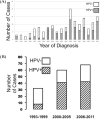The epidemic of human papillomavirus and oropharyngeal cancer in a Canadian population
- PMID: 23904762
- PMCID: PMC3728052
- DOI: 10.3747/co.20.1375
The epidemic of human papillomavirus and oropharyngeal cancer in a Canadian population
Abstract
Background: Sexually transmitted infection with the human papillomavirus (hpv) is responsible for a significant burden of human cancers involving the cervix, anogenital tract, and oropharynx. Studies in the United States and Europe have demonstrated an alarming increase in the frequency of hpv-positive oropharyngeal cancer, but the same direct evidence does not exist in Canada.
Methods: Using the London Health Sciences Centre pathology database, we identified tonsillar cancers diagnosed between 1993 and 2011. Real-time polymerase chain reaction was then used on pre-treatment primary-site biopsy samples to test for dna from the high-risk hpv types 16 and 18. The study cohort was divided into three time periods: 1993-1999, 2000-2005, and 2006-2011.
Results: Of 160 tumour samples identified, 91 (57%) were positive for hpv 16. The total number of tonsillar cancers significantly increased from 1993-1999 to 2006-2011 (32 vs. 68), and the proportion of cases that were hpv-positive substantially increased (25% vs. 62%, p < 0.002). Those changes were associated with a marked improvement in 5-year overall survival (39% in 1993-1999 vs. 84% in 2006-2011, p < 0.001). When all factors were included in a multivariable model, only hpv status predicted treatment outcome.
Interpretation: The present study is the first to provide direct evidence that hpv-related oropharyngeal cancer is increasing in incidence in a Canadian population. Given the long lag time between hpv infection and clinically apparent malignancy, oropharyngeal cancer will be a significant clinical problem for the foreseeable future despite vaccination efforts.
Keywords: Human papillomavirus; epidemiology; hnscc; oropharyngeal cancer.
Figures



References
-
- Reid JL, Hammond D, Burkhalter R, Ahmed R. Tobacco Use in Canada: Patterns and Trends. 2012 Edition. Waterloo, ON: Propel Centre for Population Health Impact, University of Waterloo; 2012. - DOI
-
- Auluck A, Hislop G, Bajdik C, Poh C, Zhang L, Rosin M. Trends in oropharyngeal and oral cavity cancer incidence of human papillomavirus (hpv)–related and hpv-unrelated sites in a multicultural population: the British Columbia experience. Cancer. 2010;116:2635–44. doi: 10.1002/cncr.21285. - DOI - PubMed
LinkOut - more resources
Full Text Sources
Other Literature Sources

